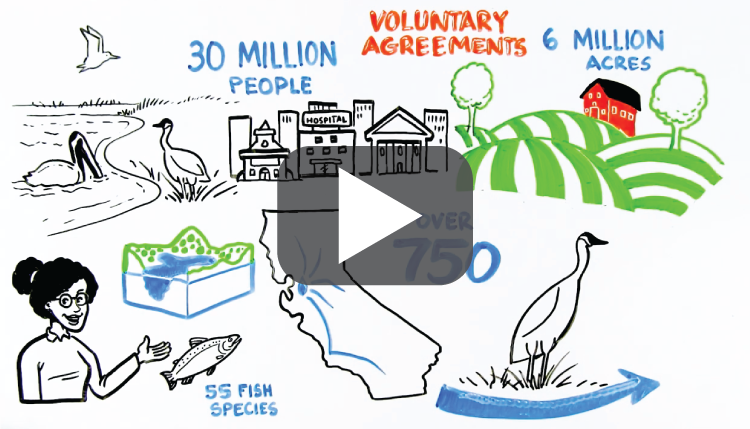The Press release below is from the California Natural Resources Agency:
SACRAMENTO – California is advancing restoration projects, streamflows for native fisheries, and a science plan in the state’s ongoing commitment to establishing and maintaining the health of our Sacramento River and Bay-Delta waterways and landscapes. By building partnerships rooted in science, California agencies and local water districts are driving progress in enhancing water reliability, restoring ecosystems, and supporting native fish populations.
More than two years ago, local, state, and federal agencies joined forces to advance a groundbreaking approach to water management and environmental restoration. The heart of this initiative is an eight-year Healthy Rivers and Landscapes Program, to improve environmental flows and restore habitats along California’s key waterways. The goal: reverse the decline in native fisheries across the Sacramento and San Joaquin rivers and their tributaries.
Now under consideration by the State Water Resources Control Board, the Healthy Rivers and Landscapes framework is a potential alternative to traditional water quality regulations in the Sacramento-San Joaquin Delta and San Francisco Bay. This approach seeks to restore ecosystem health and improve water reliability, offering a more collaborative and adaptive strategy to protect both fish and wildlife and local economies.
At the state level, this approach is being implemented and monitored by the California Natural Resources Agency (CNRA), California Environmental Protection Agency (CalEPA) and two natural resources departments: The California Department of Water Resources (DWR) and the California Department of Fish and Wildlife (CDFW).
CNRA Secretary Wade Crowfoot emphasized the unique potential of voluntary agreements to achieve balance. “The science is clear, implementing habitat projects that incorporate local landscape water flows is crucial for the health of our fish and wildlife populations. The progress we’ve made in restoring California’s rivers and ecosystems is a major win for our state and we’re just getting started.”
“California’s native fish species and our communities need action now and we are committed to fostering a collaborative, science-driven approach to managing California’s water to get that done,” said DWR Director Karla Nemeth. “By working closely with our partners, we are making strides on multiple projects that strengthen our ability to protect fish populations and local economies.”
“Thanks to unprecedented collaboration with our local, state, and federal water partners, we’re already making progress in restoring key habitats and ecosystems through the Healthy Rivers and Landscapes Program,” said CDFW Director Charlton H. Bonham. “By staying focused on the science of restoration, and by continuing to develop important statewide partnerships, we can help ensure healthier habitats for California’s fish and wildlife for years to come.”
As the State Water Board continues the essential work to update the Bay-Delta Water Quality Control Plan, partners are proactively implementing no regrets habitat restoration and water purchases to benefit native fisheries, as well as defining a science plan to inform future water management decisions.
Examples of this progress includes:
- Environmental Flows: The Instream Flow Water Purchase Program launched by CNRA and DWR June 2023 will provide $360 million to secure environmental water flows during ecologically crucial months. Proposals were submitted for nearly three times the available resources, and CNRA and DWR have identified the first two projects for preliminary intent to award – Healthy Putah Creek watershed project and Upper Swanston Ranch repurposing of agricultural water diversions for instream flows.
- Habitat Restoration: CDFW is working closely with DWR and partners to fund, permit, implement, and monitor spawning and rearing habitat restoration projects, fish passage projects, and floodplain restoration projects from Sacramento River tributaries through the Delta. These include Tide’s End, a north Delta project that will restore and enhance more than 2,200 acres of tidal and floodplain habitat; the Little Egbert Tract, a 3,000-acre project in the north Delta that will address flood-risk reduction while also building habitat for salmon, steelhead, and Delta and longfin smelt; Prospect Island, a 1,600-acre tidal restoration in the Delta that will provide habitat for native Delta fish species and migratory fish; and Sunset Pumps, a partnership with Sutter Extension Water District to pursue removal of an existing rock weir and construct a replacement pump station equipped with fish-protective screens that will prevent predation of young salmon, steelhead, and sturgeon.
- Science-Based Framework: The Healthy Rivers and Landscapes Program also includes a Science Plan and Science Committee Charter that guide research and monitoring to inform adaptive water management decisions. This model of collaborative science is designed to evaluate ecosystem responses, close knowledge gaps, and help make real-time adjustments based on the latest data.
As the State Water Board considers incorporating the Healthy Rivers and Landscapes Program as a part of its process to update the Bay-Delta Water Quality Control Plan, partners will continue to advance key components, demonstrating the program’s potential to deliver immediate benefits for California’s waterways.
Under the Healthy Rivers and Landscapes Program, California is building a pathway toward healthier rivers and resilient landscapes, showcasing an alternative model for other states and regions.
###
The California State Water Resources Control Board has posted its notice: Notice of Opportunity to Comment and Board Workshop on Draft Sacramento/Delta Updates.
For more information on the HRL program, see the whiteboard video here.





